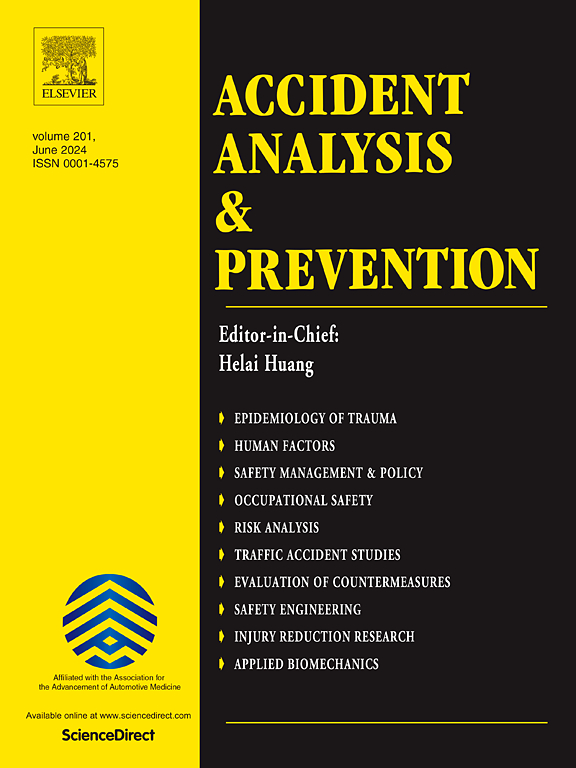A unified risk metric for freeway vehicles based on the spatio-temporal overlap probability of predicted positions
IF 5.7
1区 工程技术
Q1 ERGONOMICS
引用次数: 0
Abstract
Surrogate Safety Measures (SSMs) are widely used to quantify driving risks and support proactive traffic safety management. However, the existing metrics primarily focus on single scenarios, such as rear-end collisions in car-following situations. These metrics assume that the vehicles comply with specific motion equations, overlooking the uncertainties intrinsic to vehicle operation. To address these limitations, this study proposes a novel metric, the Risk Metric based on Predicted Position (RMPP), which evaluates the probability of collision. RMPP is designed to comprehensively capture all risk within a unified framework by incorporating the future positional distributions of vehicles. Firstly, the target vehicle and surrounding vehicles are constructed as a graph structure. The Generalized Dynamic Graph Convolutional Network (GDGCN) is used to predict the position distribution of vehicles. Then, spatial proximity risk and temporal proximity risk are computed based on the predicted positions. Spatial proximity risk is the sum of probabilities of predicted position overlap at the same time, while temporal proximity risk is the sum of probabilities of predicted position overlap at different times. RMPP is obtained through a weighted summation of these two risks. To validate the effectiveness of RMPP, we conducted experimental analyses using the Freeway B of CitySim dataset, which is collected in an Asian region using drones. We compared the prediction results of our GDGCN model with several baseline models. The experimental results demonstrated that our GDGCN model achieved good prediction accuracy. Additionally, using vehicle trajectories from CitySim, we compared RMPP with traditional metrics such as Time-to-Collision (TTC), Deceleration Rate to Avoid Collision (DRAC), and Safety Margin (SM) across both basic and high-risk driving scenarios. The results indicate that RMPP more accurately captures risk characteristics that align with real-world driving conditions. Furthermore, we evaluated the impact of prediction accuracy on RMPP by analyzing risk variations under different RMSE values. When the position prediction accuracy of both vehicles reaches a certain level, its impact on risk is small, confirming the reliability and stability of RMPP. With the advancement of technology and the improvement of prediction accuracy, the precision of RMPP will be further enhanced, making it a robust and powerful tool for traffic safety management.
基于预测位置时空重叠概率的高速公路车辆统一风险度量
替代安全措施(SSMs)被广泛用于量化驾驶风险和支持主动交通安全管理。然而,现有的指标主要集中在单一场景,例如汽车跟随情况下的追尾碰撞。这些指标假设车辆符合特定的运动方程,忽略了车辆运行固有的不确定性。为了解决这些限制,本研究提出了一种新的度量,即基于预测位置的风险度量(RMPP),用于评估碰撞概率。RMPP的目的是通过整合车辆未来的位置分布,在统一的框架内全面捕获所有风险。首先,将目标车辆和周围车辆构建为图结构;采用广义动态图卷积网络(GDGCN)预测车辆的位置分布。然后,根据预测位置计算空间接近风险和时间接近风险。空间接近风险是同一时间预测位置重叠概率的和,时间接近风险是不同时间预测位置重叠概率的和。RMPP是通过这两个风险的加权求和得到的。为了验证RMPP的有效性,我们使用CitySim的高速公路B数据集进行了实验分析,该数据集是使用无人机在亚洲地区收集的。我们将GDGCN模型的预测结果与几个基线模型进行了比较。实验结果表明,GDGCN模型具有较好的预测精度。此外,利用CitySim中的车辆轨迹,我们将RMPP与传统指标(如碰撞时间(TTC)、避免碰撞的减速率(DRAC)和安全边际(SM))在基本和高风险驾驶场景中进行了比较。结果表明,RMPP更准确地捕捉到与现实驾驶条件相一致的风险特征。此外,我们通过分析不同RMSE值下的风险变化来评估预测精度对RMPP的影响。当两车位置预测精度达到一定水平时,其对风险的影响较小,证实了RMPP的可靠性和稳定性。随着技术的进步和预测精度的提高,RMPP的精度将进一步提高,使其成为交通安全管理的有力工具。
本文章由计算机程序翻译,如有差异,请以英文原文为准。
求助全文
约1分钟内获得全文
求助全文
来源期刊

Accident; analysis and prevention
Multiple-
CiteScore
11.90
自引率
16.90%
发文量
264
审稿时长
48 days
期刊介绍:
Accident Analysis & Prevention provides wide coverage of the general areas relating to accidental injury and damage, including the pre-injury and immediate post-injury phases. Published papers deal with medical, legal, economic, educational, behavioral, theoretical or empirical aspects of transportation accidents, as well as with accidents at other sites. Selected topics within the scope of the Journal may include: studies of human, environmental and vehicular factors influencing the occurrence, type and severity of accidents and injury; the design, implementation and evaluation of countermeasures; biomechanics of impact and human tolerance limits to injury; modelling and statistical analysis of accident data; policy, planning and decision-making in safety.
 求助内容:
求助内容: 应助结果提醒方式:
应助结果提醒方式:


